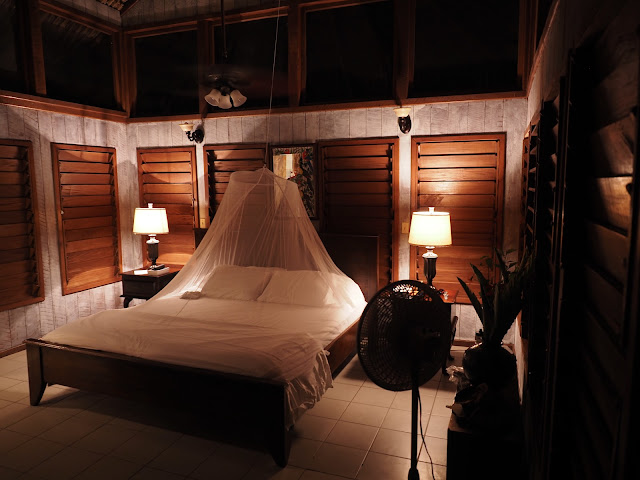We started the Belize vacation at Chan Chich Lodge, near the Guatemala border. The lodge is built in Plaza A of a Maya pyramid complex, how cool is that? An archaeological team from the Texas Tech University has been doing excavations. The site was abandoned sometime around 1000 A.D., when Mayan civilization went through a widespread collapse, probably due to a combination of drought and overpopulation. (The population of Belize at that time was probably well over a million; today it's around 420,000).
Here we are standing -- with another guest, and a guide who is taking us on an archaeology/history tour -- in the center of the A-I mound on the map above, looking down on the lodge.
Many of the pyramids have tunnels dug into them by looters looking for grave goods. According to our guide, many of the larger pyramids were built around smaller ones -- this one had about four layers -- and usually only the inner one was used as a burial; at some point the Maya stopped doing burials in pyramids. So the looters would have to dig all the way into the central part of the pyramid. By the way, these pyramids were intentionally buried, probably to keep the limestone rock from being eroded, presumably with the intent of returning when times improved. But then they didn't.
Here's our room. It looks luxurious, and it was...except: no air conditioning! And we needed that mosquito netting. The daytime temperature was in the nineties and so was the relative humidity, so it wasn't the most physically comfortable vacation. But we loved it and are already talking about going back sometime, for reasons you'll see below.
Although the archaeological stuff was cool, the main thing that drew us (and the other visitors) was the wildlife, including birds. Most of the other guests were hardcore birders. (I know some of you think that Juliet and I are hardcore birders. No. You have no idea.) One of the guys in the photo below has been to Chan Chich four times...in the past year. Here we are on a bird walk with a guide, Luis, who I think is the best guide we've ever had anywhere. Not only did he know seemingly every bird and most of the trees and bushes by name, he also knew each bird's habits, scientific name, translation of the scientific name, why the bird had that name, etc., etc. And of course he was an absolutely amazing spotter.
Below is a Rufous-Tailed Jacamar, one of many beautiful and/or interesting birds.
Below: a Slaty-Tailed Trogon.
Below: Ocellated Turkey. This is why you should never design a bird while you're drunk.
Below: Northern Potoo. Another crazy-looking bird. Check out that eye!
Below: Mottled Owl with prey (poor little fella). As you can tell from the lighting, we saw this and the potoo on nighttime drives. 

Below: a very young spider monkey. He was fascinated by us.
Below: Mom, dad, and baby spider monkeys. Like the youngster above, the baby was fascinated by us and didn't take his eyes off us for forty minutes.
Below: although the other monkeys didn't mind us at all, this one took a dislike to us...especially to Juliet. He threw sticks at her and hit her with one!
If you've ever wondered why they're called "spider monkeys", wonder no more!
Just sitting comfortably, eating a fig and watching the sunset. As one does.
In addition to spider monkeys, we also saw howler monkeys. Much bigger and heavier than the spider monkeys. They spend part of each day in howling contests with other bands of howler monkeys. They make a lot of noise. This one carefully peeled back some palm fronds so it could watch us.
After a week in the jungle we flew and then boated to Isla Marisol, on Glover's Atoll, about an hour boat ride off the mainland.
Just hours before we got there, some Cubans had "sailed" up in this ramshackle boat. They had been at sea for... I've forgotten, but it was some improbable number like 36 days. Incredible.
Every day the resort staff came out and raked the plastic off the beach. It washed up in big bunches.
We went diving twice a day, and also did a night dive. The dives ranged from good to excellent. Unfortunately the light down deep is too blue for our little GoPro camera to capture the colors as we perceived them, no matter how I adjust the white balance and such, so most of my photos are very disappointing. The one below is from very shallow water, snorkeling not scuba. Looks great, right? But if you look closely you'll see that although the fans and sponges are doing great, almost all of the hard corals are dead; there are just two little spots of living coral in this photo.



























A great travelogue! Glad you shared this.
ReplyDeleteAlso, what a fantastic turkey! That may be a strange one to pick out but I had seen some of the others but not this one. It was a pleasant surprise.
ReplyDelete